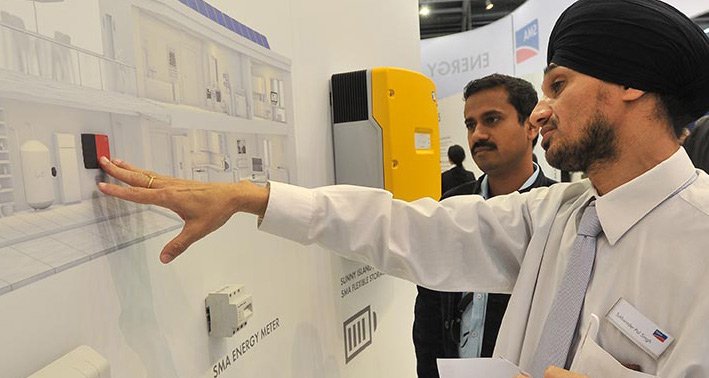Automotive Manufacturers Conquer the Storage Market

At least since the end of April, when Tesla introduced its Powerwall, everyone seems to be talking about the market for stationary battery-storage systems. At any rate, it was the dominant topic at Intersolar. I asked Volker Wachenfeld, an SMA expert in storage technology, about his assessment of the market and SMA’s plans for battery-storage systems going forward.

Volker Wachenfeld has a degree in electrical engineering and is Executive Vice President of the Offgrid & Storage Business Unit at SMA.
You’ve just come from the Intersolar Europe trade fair in Munich. How important was the topic of battery-storage systems at that event?
Halls B1 and B2, where the storage systems were displayed, seemed to attract more visitors than any other part of the fair. Nowhere else were there so many people milling around; no other area was the scene of such intense discussions. I were in meetings throughout the three days, and they were all about storage. We hope this means that the topic has become a permanent part of the photovoltaics landscape, and is not just temporary hype.
Are customers responding to this topic?
Yes, definitely. In contrast to last year, very few manufacturers of makeshift solutions participated in the trade fair. Instead, established manufacturers strengthened their presence. In addition, there were OEMs from the automotive industry, such as BMW, Daimler, and Tesla, which intend to create added value with their own solutions. Many are focusing on the German market, but Japan, the U.S., and Australia seem to be gaining in importance as well.
In your opinion, what was the most exciting new development at Intersolar?
I thought that the professionalization of systems was the most exciting thing we saw—the systems are available, ready to buy, serious, mature. No one has reinvented the wheel, but then, no one needed to.
Tesla has caused quite a furor with the announcement of its Powerwall. Did you visit Tesla’s booth? Is cooperation conceivable?
Tesla’s Powerwall was everywhere at the trade fair. It was introduced at a wide variety of booths, and thanks to its brilliant market launch, everyone was talking about it. We are delighted that Tesla has done a great deal to raise awareness of storage systems, and this can only benefit the market. I visited the company’s factory in Palo Alto, California, most recently in the fall of last year, and of course I also met with Tesla representatives at the trade fair. As we announced at the trade fair, we will be able to offer a solution for the Powerwall in time for its launch.
Just as the trade fair was being held, SMA announced two new cooperative ventures with battery manufacturers. Can you briefly explain how these ventures will benefit customers?
I believe that lithium technology has triggered the biggest wave of innovation in the market, and that wave is far from over. So that our customers are always able to employ the most cost-effective solutions, we are constantly working to ensure the success of the technology on the market. To that end, it is important to work with the best in the industry rather than limiting ourselves to a single manufacturer. Cooperation gives us access to the information we need to be at the forefront.
What’s next for SMA in the field of battery-storage systems?
More than almost any other company, SMA stands for a decentralized energy supply. Battery-storage systems add a very important feature to PV systems—they provide “maturity,” which for us means availability, dependability, and predictability, among other things. Our task is to make these features available to our most important PV markets in the required system sizes. We are already well positioned for residential applications thanks to our Flexible Storage System and Sunny Boy Smart Energy. In the utility grade sector, the first large storage projects went into operation this year. By making multicluster technology available for grid-connected applications, we have opened the door for storage use in the commercial area. We are carefully watching the markets, and in the current situation we must, of course, prioritize—we can’t do everything, but we can be sure to address the most important issues in a sustained manner to make sure that we’re not left behind.
Finally, please complete the following sentence: In 10 years battery-storage systems will…
… be a standard feature of every PV system, ensuring that energy generated by photovoltaic means will begin to replace conventional power plants both sustainably and completely.
Volker, thank you very much for talking with us.
More information
High voltage or low voltage – what’s the right solution for household PV-plus-storage systems? (pv tech storage blog)
Aquion Energy Batteries Now Officially Supported by SMA (press release)
BYD’s B-BOX will successfully cooperate with SMA Sunny Island Inverter (press release)
Sunny Boy Smart Energy (product information)
Sunny Island (product information)



Are you considering the use of super capacitors instead of batteries for energy storage?
Hi John,
Thanks for your question. Batteries today are already used in various applications in the context of decentralized power generation, e.g. peak shaving, grid support, renewable integration including power smoothing, ramp rate control etc. All of these applications require a different power to energy ratio, typically classified by the so called c-rate, the P(ower)/E(nergy)-rate. Energy shifting requires a lot of energy at comparably low power, this is the standard requirement for home energy storage. If you look at the Tesla Powerwall, it can provide 2 kW of power, with an energy capacity of 7 kWh. The c-rate of this battery is approx. 0,3, other batteries for similar applications provide a c-rate of 1, meaning that 1 kWh of capacity is capable of providing a power of 1 kW. High power battery applications go up to c-rates of 3 .. 4, allowing to smoothen the power output e.g. of wind turbines.
Super capacitors – in contrast to batteries – allow applications with very high power demands, but with limited energy to be stored. The typical P/E-ratio is 100+, so the costs per “kW” (power) are very low, whereas the costs per “kWh” (energy) are too high for the application we are targeting. Typical applications for super capacitors are regenerative braking systems in trains or electric vehicles (recuperation), pitch drives for wind turbines etc., all classified by a short-term, very high power demand.
For this reason, we currently do not use super capacitors in the context of decentralized power supply. Regarding costs per kWh, batteries are still much more cost effective than super capacitors. But we keep an eye on this development to identify game changing factors in the technological development of any kind of decentralized storage technology.
Best regards,
Leonie